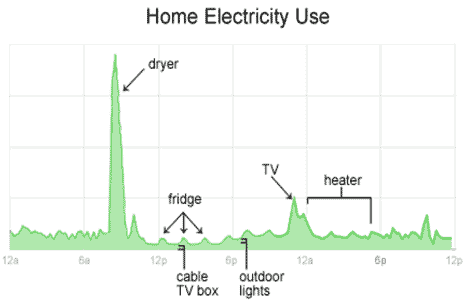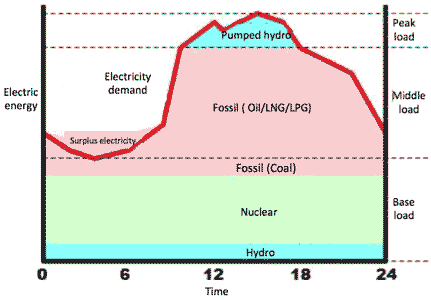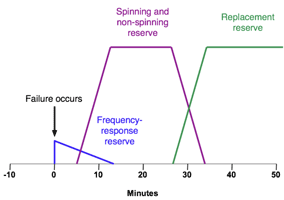Reform of the electric system
|
Cat: ENE |
|
Norio Murakami (村上憲郎) |
12909u/18208r |
Title
Reform of the electric system can break ground for ICT frontier
電力システム改革がICTフロンティアを切り拓く
Index
Tag
Smart meter TED5000; PPS; Negawatt; HEMS; DR aggregator; Separation of power generation/distribution; IOT; ARPA-E
Why?
- The author was former president of Google-Japan, and now visiting professor of Glocom, IUJ, who presides FTM (Future Technology Management), a workshop of Glocom studying a forthcoming Smart Society in Japan, particularly after the North Japan disaster on 3/11/2012.
- This is a summary of the report lectured by the author on 7/24/2012 at the workshop in Glocom, IUJ.
- The detailed FTM activities are uploaded at: http://www.glocom.ac.jp.
- 著者は、前Google-Japan社長で、現在は国際大学GLOCOM客員教授で、特に東北大震災以降の日本のスマート社会についてのGlocomの研究ワークショップ(FTM)を主宰している。
- 本レポートは7/24/2012GLOCOMでの発表サマリーである。
English resume
Japanesse resume
>Top 1. Smart Grid:
 Smart grid is defined as a grid converging electricity grid and information grid. Therefore, all things connected to the present electricity grid could be also connected to the smart grid. The information grid converged into the smart grid is the Internet. Thus, the things connected to the electricity grid could be automatically connected to the Internet.
Smart grid is defined as a grid converging electricity grid and information grid. Therefore, all things connected to the present electricity grid could be also connected to the smart grid. The information grid converged into the smart grid is the Internet. Thus, the things connected to the electricity grid could be automatically connected to the Internet.
- Smart grid could be IOT (Internet of Things)
- In Japan, all homes are connected electricity grid, and major homes are equipped with fiber optics or mobile WiFi network and are using the Internet. But these situations couldn't be said as smart houses; because they can neither see power consumption nor control it by Internet.
- Smart Meter matters: called 'sumame' in Japan.
- The smart meter has interface with LAN or WiFi.; the power consumption data can be assessable by Internet.
- The data can be sampled every 30 minutes or shorter intervals.
>Top
- Google has chosen smart meter: TED 5000 (made by The Energy Detective
- Smart meter measures data based on ANSI C12.20 0.5% accuracy class standard.
- How TED 5000 works:

- Electric power is sent to a home's breaker panel.
- CTs (Current Transformers) and MTU (Measuring Transmitting Unit) are installed in the breaker panel and measure household energy.
- MTU transfers data over power line to the gateway.
- Gateway transmits signal via ZigBee (shore range wireless protocol) to In-house Display.
- Gateway connects to wireless router or directly to computer via Ethernet.
- View data on computer via Footprints software.
(Focus-context display?)
- Point in controversy:
- Whose is the power consumption data? Consumer or power utility?
- How the data is available?
- Via electric power utility (Route-A)
- at HAN (Home Area Network) (Route-B)
- Where is the smart meter installed?
- out of the door
- within the door
- MDMS (Metering Data Management System):
Can PPS also use the same smart meter?
>Top
- PPS (Power Producer and Supplier): new electric power company who can supply big consumers (not less than 50kW).
- Sampling interval: 30 min or less (say 5 min)
 Visualization of power consumption at each home:
Visualization of power consumption at each home:
- Smart plug: prior to the advent of smart appliance.
- Fujitsu:
Smart plug: FX-5204PS; Gateway: FX-5250GW
- Smart meter as well as smart appliance increase the opportunities for demand response by providing real time data.
1. スマートグリッド:
- スマートグリッドは、電力網と通信網を論理的に束ねたもの。
- 即ち、電力網とインターネットが束ねられたもので、電力網に接続しているすべてのものは、インターネットに接続される。
- 即ち、Smart Socity = IOT (Internet of Things)となる。
- 日本では、すべての家庭には電力線があり、多くの家庭に光ファイバやモバイルWiFiがありインターネットを利用している。しかしこの状況はスマートハウスとは言えない。なぜなら消費電力を見ることも制御することもできない。
- そこでスマートメータ (いわゆるスマメ) が重要になる。
- スマートメータにはLANやWiFiとのインターフェイスを有し、消費電力データがインターネットからアクセスできる。
- 少なくとも、電力会社とデータ共有し、30分またはそれより短い時間で消費電力データを利用できる。
- Googleは、The Energy Detective社のTED5000を選択
- TED5000の特徴:
- 配電盤に、CT(電流の計器用変流器) とMTU (電圧計測送信機)を設置
- MTUが電力線をつかったデータをゲートウェイに総員
- ゲートウェアはZigBeeプロトコルでディスプレイに無線通信
- ゲートウェイは無線ルートまたはイーサーネットと接続
- コンピュータ搭載のFootprintsソフトで使用電力を表示
- 論点:
- 消費者電力のデータは誰のものか?ユーザが電力会社か
- データ入手ルート:
- 電力会社経由 (Aルート)
- HAN (ホームエリアネットワーク)経由 (Bルート)
- スマートメータの設置場所:
- 屋外
- 屋内
- MDMS:スマートメータのデータ管理システム
- PPS (特定規模電力事業者=新電力); 50kW以上の大口需要家に販売可能
- サンプル間隔: 30分さらに短時間 (5分など)
- 各家庭における消費電力の見える化:
- スマートコンセント
- スマート家電と並んでスマートメータはリアルタイムでのデータを則的でデマンド・レスポンスを実現
>Top 2. Demand response:(DR):
 Taking the lessons learned from CA blackout in 2000, USDOE created a way to balance electricity supply and demand without constructing new power stations or transmission lines; this mechanism is called "Demand Response."
Taking the lessons learned from CA blackout in 2000, USDOE created a way to balance electricity supply and demand without constructing new power stations or transmission lines; this mechanism is called "Demand Response."- DR is a way to decrease demand by market mechanism (price incentive), not by enforcement (such as rolling blackouts) or volunteer spirit.
- The peak electricity which users decrease by this mechanism is >Top called "Negawatt." In US, this negawatt can trade at corresponding megawatt electric supply capacity.
- Thus DR can reduce peak consumption (kW) in a critical hours.
- Cf:
- kW is insufficient in critical hours, but kWh is sufficient in a day.
- CPP (Critical Peak Pricing)
- TOU (Time of Use)
- RTP (Real Time Pricing) >Top
- HEMS (Home Energy Management System)
- Toshiba acquired (60%) Landis+Gyr of Swiss, top maker of smart meter.
- MDMS (Meter Data management System); installed at the electric utility
- AMI (Advanced Metering Infrastructure); smart grid infrastructure
- GO (Grid Optimization)
- DG (Distributed Generation)
- HG (Home Grid)
- ES (Electric Storage)
- FAN (Field Area Network); network connecting home and electric utility
2. デマンドレスポンスとは:
- 2000年の米国CA州の停電を教訓に、DOEは、新規の発電設備を建設することなしに、需給をバランスさせるための手法を編み出した。 (DR)
- 需要を、強制やボランタリーに訴えるのではなく、市場メカニズム (価格インセンティブ)による需要減を狙う。
- ピーク時の需要減を"ネガワット"という。米国では、このネガワットを供給のメガワットとほぼ同等の価値で市場取引している。
- 足りないのはkWであって、kWhではない。
- 用語:
- CPP (Critical Peak Pricing):緊急時ピーク料金
- TOU (Time of Use) :時間帯別料金
- RTP (Reat Time Pricing) :リアルタイム料金
- HEMS (Home Energy Management System):ホームエネルギー管理システム
- 東芝はスイスのスマートメータメーカのLandis+Gyr 社を買収 (60%)
- MDMS (Meter Data Management System): 電力会社内に設置
- AMI (Advanced Metering Infrastructure):スマートグリッドのインフラ
- GO (Grid Optimization) :送電網最適化
- DG (Distributed Generation):分散発電
- HG (Home Grid) :ホームグリッド
- ES (Electric Storage):蓄電システム
- FAN (Field Area Network):家庭と電力会社を接続
>Top 3. Impact of DR: (as of 2011/5)
- Estimate as of 2011/5 is as follows:
- Number of smart meters installed in Japan within a year: 1M households
- Unit price of a smart meter: @¥10K × 1M = ¥10B
- 10A could be decreased at peak hours: 100V × 10A = 1kW
- The total negawatt will be: 1kW × 1M = 1GW (= one Nuclear plant capacity)
- Compensation for the negawatt:@¥20/kWh x 1M = ¥20M/h = ¥1.2B/60 hours
3. デマンデレスポンスのインパクト:
- 2011/5時点での試算:
- スマートメータの普及:100万戸
- その金額:@1万 x 100万=100億円
- 緊急時に10A下げると想定:
100V × 10A= 1kW
- 1kW × 100万戸= 100万kW(原発1基分)
- これは100万kWのネガワット発電
- 節電による料金低下に加えて、スマートメータの記録による協力費支払
1kW × 1h = 1kWh (=20円支払)
- 原資は 100万kW発電設備投資 (1000億円)を行わないで済んだ資金から
>Top 4. New electricity infrastructure by smart grid:
- Fair competition by a variety of power generation:
- Existing power generation
- Solar, Wind, Geothermal, Low head hydro, LNG, New nuclear, etc.
- Various opportunities of electric industry: >Top
- DR aggregator, Large scale battery (Sodium-sulfur or NaS battery), Ancillary business, Demand estimate business, Power generation (kW, kWh) estimate, etc.
- kW is power, while kWh is energy.
4. スマートグリッドが支える新たな電力インフラ:
- 多様な発電事業者参入による公正な競争
- 多様な電力事業の創設機会
- DRアグリゲーター
- 大規模蓄電事業
- 関連事業
- 需要予測事業
- 発電予測事業 (kW, kWh)
>Top 5. Electricity liberalization:
- >Top
- There are various types of separation of power generation and distribution:
- Account separation:
- Separate account related to power generation and distribution
- Legal separation:
- Separate power generation company and distribution company. Both companies may be integrated under a holding company.
- Operational (Functional) separation:
- Separate operation of power distribution by ISO (Independent System Operator).
- Ownership separation:
- Separate independent companies (with separated capital) of power generation and distribution.
- Issues:
- Power distribution tends to be natural monopoly.
- Appropriate investment in the monopolized services should be guaranteed.
- Balance of price decline and stable supply.
- Compare with airline companies (=power generation), and airport operation companies (=power distribution). What would happen if one airline company controls all airport operation.
5. 電力自由化:
- さまざまな発送電分離があり得る。
- 会計分離
- 発電、送電部門に関する会計を分離
→形式分離
- 法的分離
- 送電会社を分離するが、持株会社方式も可能 →NTT型
- 機能分離
- ISO (独立系統運用機関)といった中立組織が系統運用を実施 →米国型
- 所有分離
- 送電部門の試算保有も別会社 (資本関係を認めない) →EU型
- 論点:
- 送電部門は自然独占
- 独占サービスでは適切な投資が行われるか
- 価格下落と安定供給のバランス
- 航空会社 (=発電)と空港運営会社 (=送電)との比較。もしある航空会社1社が、すべての空港運営を支配したらどうなるか?
>Top 6. Front line of ICT:
- New horizon of the Internet:
- PC: 1.9B (from iPad to mobile internet)
- Cellular phone: 5.3B (fro/hm mobile phone to smart phone)
- TV set: (from AppleTV or GoogleTV to smart TV)
- Smart grid terminal: almost innumerable like:
smart house, smart meter, smart appliance, smart car (PHV=Plug-in Hybrid Vehicle; EV), smart parking, etc. >Top
- Development of IoT (Internet of Things):
2010s of IoT development
corresponds to 1990s of the Internet.
- !st application of IoT: Visualization of electric power
- 2nd application of IoT: Demand response (DR)
- 3rd application of IoT: Watching (status monitoring) service
- 4th application of IoT: Revolutionary application from dormitories of university.
- Big data:
- Big data 1.0: Customers profile of the operator's screen.
- Big data 2.0: Semantic analysis of human beings. OSTP (Office of Science and Technology Policy of US White house) announced $200M R&D for this technology.
- From DARPA to ARPA-E: Change of innovation strategy of US.
- DARPA (Defense Advance Research Projects Agency) of DOD:
- AI
- DARPAnet (Internet) >Top
- ARPA-E: (Advanced Research Projects Agency-Enregy) of DOE formed in 2009; modeled after DARPA.
- Technical challenges and opportunities to connect knowledge of what science is capable of to what technology can achieve and what the market needs; hosted or cohosted 13 technical workshops, including:
- solar cells, wind turbines, geothermal drilling, biofuels, and biomass energy crops.
- energy efficiency including power electronics, engine-generator, waste heat recovery, smart glass, smart building, light-emitting diodes (LED), reverse-osmosis membranes, catalysts to split water into hydrogen and oxygen, magnetic material
- energy storage including ultra-capacitor, lithium-ion batteries, metal-air batteries that use ionic liquids, liquid sodium batteries and liquid metal batteries.
- bioreactor, crystal growth to lower the cost of LED.
- Electric storage
- Chemical storage: Lithium ion battery, Zinc-air battery having property of fuel cells as well as batteries.
- Heat storage:
6. ICT最前線:
- インターネットの新地平
- PC:19億台 (iPadからモバイルインターネットへ)
- 携帯電話 (ケータイからスマートフォンへ)
- TV受像器:AppleTV およびGoogleTVからスマートTVへ
- スマートグリッド端末:無限台
スマートハウス、スマートメータ、スマートアプライアンス、スマートカー (PHV, EV)、スマートパーキング等々
- IoTの発展:
IoTの2010年代は、インターネットの1990年台に匹敵
- IoTの第1のアプリ: 電力の見える化
- IoTの第2のアプリ: DR
- IoTの第3のアプリ: 見守り?
- IoTの第4のアプリ: ??
今度こそ、日本の大学の寮から革命を!!!
- ビッグデータ:
- ビッグデータ1.0:顧客プロファイル情報をオペレータスクリーン上に表示
- ビッグデータ2.0:人となりを含めた人間全体の意味を捉える (意味解析が必要)
- DARPA (DOD)からARP-E (DOE)へ
米国イノベーション戦略の転換
- DARPA: AI、DARPAnet (=インターネット)
- ARPA-E:再生可能エネルギー、蓄電技術他
Ref
>Top Re: Demand Response (DR):
- Various services of electric supply:
- Electric power (EP) energy (kWh)
- Day ahead market and real time market
- JEPX (Japan Electric Power Exchange)
- Electric power generation capacity (kc)
- Capacity market:
To secure sufficient generation capacity in the future, the capacity itself is traded in the capacity market.
- Ancillary services
- Additional services necessary to support reliable transmission of electric power; such as scheduling, reactive power and voltage control, loss compensation, etc.
 Operation reserve: (Source: Wikipedia)
Operation reserve: (Source: Wikipedia)
is the generating capacity available within a short time to meet unexpected demand as the following 4 kinds of reserve power:
- Frequency-response reserve; automatic reaction to a loss in supply
- Spinning reserve; already connected to the power system.
- Non-spinning reserve; brought online after a short delay
- Replacement reserve; require longer start-up time
<参考>デマンドレスポンス
- さまざまな電力供給サービス:
- 電力エネルギー
- 前日市場と当日市場
- 日本卸電力取引所(JEPX)では、前日市場と当日実運用4時間前までの市場で取引。
- 発電容量
- 将来の十分な発電容量を確保するために、容量自体が、発電容量市場で取引される。
- 付随的サービス
- 発電予備容量:
以下4種類の予備がある。
- 周波数応答予備:
供給源に対する自動対応
- 運転予備力:系統接続済スタンバイ
- 運転準備予備力:系統接続準備スタンバイ
- 代替設備予備
Comment
- >Top The Fukushima nuclear plants disaster on 3.11 in 2011 has given serious impact to the Japanese economics and society. The disaster could be a decisive change from the postwar economic regime in Japan; i.e., redefining concentrated scale-merit pursuing economy to more distributed and more autonomous economy in Japan.
- The regionally monopolized electric industry has been solid regime since postwar Japan. But after 3.11 it is arising a serious controversy how to make the reform of Japanese electric industry, or, how to promote power generation and distribution in Japan as well as how to realize phase-out of nuclear power generation.
- 3.11の福島原発震災は、日本経済と社会に深刻なインパクトを与えた。その災害は戦後の日本の経済体制を変化を決定づける可能性がある。即ち集中型規模追求の経済からより自律分散型の経済への転換である。
- 地域独占の電力産業は、戦後日本の強固な体制であった。しかし3.11以降、電力改革が大きな論点に浮上してきた。即ち発送電分離をどう実現し、原発からの脱却がどう実現するかの議論である。
Title |
Reform of the electric system can break ground for ICT frontier | 電力システム改革がICTフロンティアを切り拓く |
|---|---|---|
Index |
||
Tag |
Smart meter TED5000; PPS; Negawatt; HEMS; DR aggregator; Separation of power generation/distribution; IOT; ARPA-E |
|
Why? |
|
|
English resume |
Japanesse resume |
>Top 1. Smart Grid:
|
1. スマートグリッド:
|
>Top 2. Demand response:(DR):
|
2. デマンドレスポンスとは:
|
>Top 3. Impact of DR: (as of 2011/5)
|
3. デマンデレスポンスのインパクト:
|
>Top 4. New electricity infrastructure by smart grid:
|
4. スマートグリッドが支える新たな電力インフラ:
|
>Top 5. Electricity liberalization:
|
5. 電力自由化:
|
>Top 6. Front line of ICT:
|
6. ICT最前線:
|
Ref |
>Top Re: Demand Response (DR):
|
<参考>デマンドレスポンス
|
Comment |
|
|